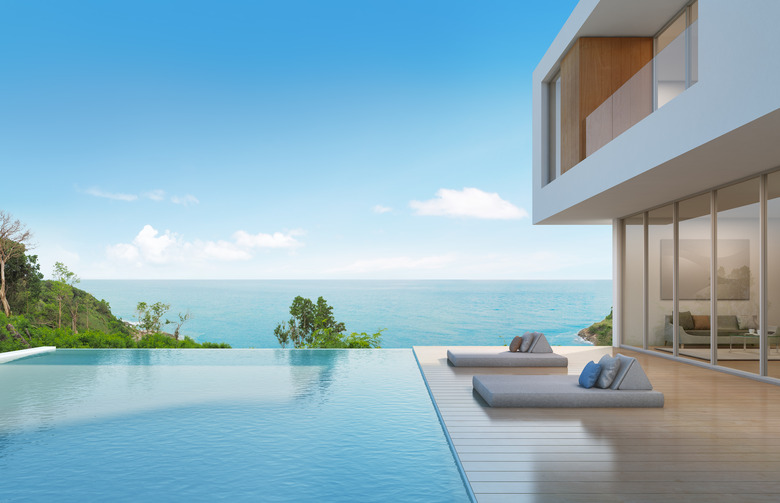What Causes Black Algae In My Pool?
Of the many types of algae that can grow in a swimming pool, black algae is the most troublesome. It has more resistance to chlorine than other types of algae, and once it establishes itself in the pores of a concrete or gunite pool, it is very difficult to remove. Black algae usually finds its way into the pool on the body or bathing suit of someone who has recently been swimming in a natural body of water, such as a lake or the ocean. Dogs can also carry the algae into the pool on their paws or in their fur. A properly functioning pool filter will remove it, but if the filter hasn't been maintained, the algae can quickly grow into a problem.
What Is Black Algae?
This algae may appear black in the pool, but when you retrieve a sample and rub it on a piece of white paper, you'll notice a greenish tinge. It's an example of a cyanobacterium; it's related to spirulina, another type of blue-green algae, and to red algae, which also grows in swimming pools. None are true algae, but classes of bacteria that manufacture their own food by photosynthesis. They get their name from the bluish pigment [](http://www.ucmp.berkeley.edu/bacteria/cyanolh.html) _phycocyanin,_ which captures the sunlight they need. Spirulina is known for its nutritive value, but the black algae you find in a swimming pool has no such value and is probably toxic.
Conditions for Algae Growth
Algae love dirty water, and pool water can become dirty enough to support them if the filter isn't doing its job — even if you maintain the proper chemical balance. The algae can grow when a clogged filter or skimmer basket prevents water from circulating through the filter. It can also grow if you fail to run the filtration system every day or if the motor is defective. When the filtration system isn't working properly, the water can turn cloudy, and that's the sign that conditions are right for algae growth. Once you see black spots forming on the surface of the water, the algae has become established.
What to Do About Black Algae
Getting rid of black algae isn't easy. You can't kill it by simply shocking the pool water, because it forms a coating that protects it from chlorine. Using pool shock is part of a comprehensive remediation program, but to make it work, you have to scrub the algae to remove this coating. In addition, you have to backwash the filter. Here's a sample remediation regimen:
Things Needed
- Garden hose
- Hard-bristle brush
- Rubber gloves
- Chlorine tablets
- Pool shock
- Granular chlorine
- Algaecide
1. Clean the Filter Cartridge
If you have a DE or sand filter, backwash it and rinse it off. If you have a removable cartridge, take it out and rinse it off with a garden hose.
2. Scrub the Black Spots
Use a hard-bristle brush to scrub the algae on the pool liner, ladder and anywhere else it is growing. You're not actually trying to remove it, but just removing the protective coating that prevents the disinfecting chemicals you're about to use from getting to its roots. After scrubbing with a brush, put on a pair of rubber gloves and scrub each of the black spots with a chlorine tablet.
3. Shock the Pool
Use three times the amount of sodium dichlor pool shock you would normally use. So if the packet recommends 1 pound per 10,000 gallons of water, use 3 pounds. If you have a light-colored pool, you can supplement this treatment by sprinkling granular chlorine on the surface of the water near the black spots. Don't do this if you have a dark-colored pool, because the bleach may alter the color.
4. Add an Algaecide
Follow the instructions on the container to add the proper amount for the volume of your pool.
5. Run the Filter
Leave the filter off for 24 hours if you have a light-colored pool, but turn it on immediately if you have a dark-colored one to circulate the water and prevent the chlorine from bleaching out the color. Once you start the filter, let it run from 24 to 48 hours.
6. Brush and Shock Again
If you still see black spots, brush them again with a brush and a chlorine tablet. Shock the pool again, but this time, use a normal dosage. Run the pump for an additional 24 hours. Continue brushing for three to four days while the chlorine levels in the pool are elevated.
Tip
You'll probably want to stay out of the pool for several days because of the elevated chlorine levels. It could take two weeks for the chlorine levels to return to normal.
